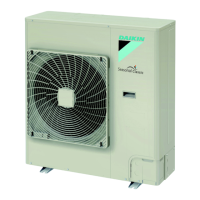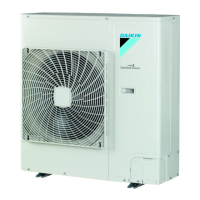
Do you have a question about the Daikin RZQSG100L8V1B and is the answer not in the manual?
| Brand | Daikin |
|---|---|
| Model | RZQSG100L8V1B |
| Category | Air Conditioner |
| Language | English |
Describes warning classifications according to severity and probability of occurrence.
Defines key terms like Installation manual, Operation manual, Dealer, Installer, and User.
Safety instructions for preventing electric shock during installation and servicing.
Precautions to avoid burns or frostbite from hot or cold piping and internal parts.
General warnings and cautions for installers regarding installation safety and potential hazards.
Installation information, including earthing, gas pipes, water pipes, and potential electrical risks.
Defines manual scope, general precautions, and specific notes on compressor insulation.
Specific precautions for handling R410A refrigerant, emphasizing cleanliness, dryness, and tightness.
General installation notes, including pipe branching kits and thermistor precautions.
Explains model differences and provides instructions on how to properly handle the unit.
General criteria for selecting an installation site, ensuring ventilation, safety, and accessibility.
Specific guidance for selecting installation sites in cold climates to prevent wind exposure and snow issues.
Details on ensuring a strong, level foundation and securing the unit to prevent falling.
Instructions for drain pipe installation and required service space around the unit.
Specifies construction material and temper grade for refrigerant piping, emphasizing seamless copper.
Provides guidelines for selecting appropriate refrigerant pipe sizes based on model and system configuration.
Guidance on selecting branch pipes for twin, triple, and double twin systems.
Details allowable pipe lengths and height differences for various system configurations.
Specific instructions for branch piping and creating flares for refrigerant connections.
Guidance on brazing, stop valve operation, and handling stem caps and service ports.
Specifies tightening torques and methods to prevent foreign objects from entering the system.
Guidance on connecting field piping and ensuring proper insulation to prevent condensation.
Explains when and where to install traps in riser gas piping to ensure oil return.
Outlines general procedures, setup, and guidelines for leak testing and vacuum drying.
Details the procedures for performing both vacuum leak tests and pressure leak tests.
Instructions for vacuum drying and key information about the R410A refrigerant.
General precautions and guidelines to follow when charging refrigerant into the system.
Explains how to calculate the amount of additional refrigerant needed based on piping length.
Information on when complete recharging of refrigerant is necessary and how to perform it.
Provides a table detailing total refrigerant charging weights based on piping length.
Describes the procedure for performing pump down operation for refrigerant recovery.
Emphasizes electrician requirements, high voltage safety, and general wiring precautions.
Details on connecting power supply and wiring between indoor and outdoor units.
Further precautions for wiring power supply and inter-unit connections, including terminal tightening.
Provides specifications for standard wiring components like circuit breakers, fuses, and wire types.
Safety warnings, initial power input notes, and essential pre-run checks before test operation.
Guidance on remote controller settings and step-by-step instructions for performing the test run.
Important precautions to follow during test runs, including auto-switching to heating and handling unusual reasons.
Troubleshooting guide for common initial installation failures and error codes displayed on the remote controller.











